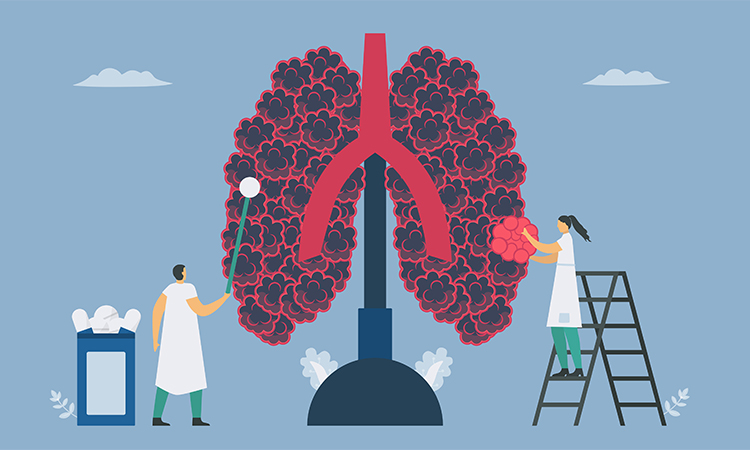Drug discovery for COPD treatments
Posted: 16 November 2022 | Ria Kakkad (Drug Target Review) | No comments yet
In this article, Drug Target Review’s Ria Kakkad shares some of the most recent progress in discovering a drug for COPD, a disease that remains a major challenge in the medical industry.


Chronic obstructive pulmonary disease (COPD) is a group of lung conditions that trigger breathing problems. It remains a major medical challenge that results from smoking and pollution; according to the World Health Organization (WHO), it is the third leading cause of death worldwide. There are many treatments available to slow respiratory symptoms, such as coughing, but there is no cure.
At ELRIG’s recent event on Drug Discovery, speakers from academia and industry came together to discuss methods to identify molecular targets to find new drugs for COPD. This article shares up-to-date progress in research and new ways in which scientists can enhance their research. During the event, I was also able to speak to influential scientists in the area, Professor Ian Adcock from Imperial College London and Dr Luigino Calzetta from University of Parma, whose insights are included in this article.
Recent progress towards a drug for COPD
In the recent years of research, scientists have started to recognise that COPD is a syndrome with both changes in the respiratory system and systemic co-morbidities, especially in the cardiovascular systems and depression. Current therapies, such as bronchodilators, are generally administered by inhalation to treat the respiratory symptoms, with drugs mainly developed to avoid entering the systemic circulation to prevent unwanted effects. However, future research needs to consider systemic treatments to also address these important co-morbidities.
Research has not focused on what could be an early aspect of COPD or if it is something that develops in utero or early age”
Researchers are looking for new drugs and although there have been a wide range of studies on the disease, treatments remain limited to medications such as bronchodilators.
When speaking to Adcock, he emphasised that a reason for this could be the lack of understanding of COPD in its early stages of disease. He argued that COPD has traditionally been thought of as a “self-inflicted disease of long-time smokers, especially affecting old men. Therefore, research has not focused on what could be an early aspect of COPD or if it is something that develops in utero or early age.”
Adcock also mentioned that patients have different phenotypes and different genetic components that will increase their risk of developing COPD. It is not only smokers who are prone to the disease, but also those “who are more exposed to environmental pollution and people cooking over wood smoke. One of the highest risk factors for COPD is early life asthma and repeated respiratory infections. We need to prevent these.”
Calzetta added that another challenge regarding identifying drugs is due to the “lack of knowledge on the intimate pathophysiological mechanisms of COPD,” or the prognostic evolution of adverse functional changes related to the disease. For example, for COPD patients, the effects of the disease may start with damage to the small airways which could progress from a cough with mucus to difficulty breathing and sever forms of the disease. While there are available treatments to cope with these effects, the damage cannot be undone.
Selecting the right models to study the disease
It is a well-known fact and strenuous challenge in the drug discovery industry that novel molecules and therapeutics that are successful in pre-clinical studies tend fail more than often in Phase II clinical trials. Therefore, new pharmacological modalities are needed to find drugs more rapidly.
COPD research is no exception and a key topic is how to select the right model when studying the condition to ensure that there is a greater chance of the findings being able to translate to patients.
At ELRIG, I also attended a fantastic presentation by Dr Simon Pitchford from King’s College London on choosing the most efficient animal model for testing drugs during the pre-clinical stages of research. For example, using mice or rats has great advantages in that scientists can replicate early symptoms of COPD. However, mice do not cough, which is an important later-symptom of the disease. Therefore, good quality data is difficult to obtain from these models.
Guinea pigs, on the other hand, can replicate COPD symptoms such as coughing. However, a key disadvantage is that the airways of this animal contain an axon reflex, which is absent in humans and we lack the molecular tools available in other species.
Overall, Pitchford emphasised that as all lab animals are quadrupeds, their posture and influence of gravity is completely different to humans, which will have an impact when translating their results to patients. Therefore, using ex vivo models in addition to animal models will allow for a better understanding of the disease in pre-clinical research.
There is a lack of knowledge on the intimate pathophysiological mechanisms of COPD”
For example, Pitchford argued that human isolated bronchial tissues enable a full pharmacological characterisation of novel compounds, both agonists and antagonists. These results can also give the characterisation of the inflammatory fingerprint at the level of target issue. Therefore, ex vivo COPD models provide suitable and translatable results and gives the possibility of performing very accurate qualitative and quantitative assessment of drug-drug interaction.
Adcock also agreed, arguing that “if we use animal models sensibly in combination, then we can really make progress.” An advantage to using animal models over ex vivo is that, at a transcriptomic and physiological level, animal models can give researchers signs and symptoms that match human disease. Adcock suggested looking at the whole life cycle of disease with animals, looking at the first day of smoking all the way until severe COPD which could give insight into early biomarkers.
The future of COPD research
Calzetta predicted that “for a long time, we will probably remain linked to the current therapy of COPD by modulating the drugs that we have in triple combination therapy. For example, by reducing the dose of inhaled corticosteroids combined with a LABA and a LAMA. Unfortunately, excluded phosphodiesterase inhibitors, the current pharmacological research does not open new perspective for innovative treatments of COPD in the next future. He is also excited about the fingerprint profiling of inflammation for each population of COPD patients as it could lead to personalised therapy for smaller groups of patients.
Additionally, Adcock is quite enthusiastic about future research into COPD as there is a community of stakeholders, pharmaceutical companies, clinicians and researchers who are all working together towards a drug for the disease. Adcock explained, “by understanding COPD, we will be able to develop drugs that have a better chance of working in a subset of patients with different phenotypes.”


He was a principal investigator in the MRC-ABPI COPD MAP initiative and was awarded the ERS GOLD medal for COPD in 2019.


Calzetta is in the top 5 most highly cited researchers in the world on bronchodilator agents and received the Chest Young Researchers Award.
Related topics
Biomarkers, Disease Research, Ex Vivo, In Vitro, In Vivo, Pathology & Molecular Medicine, Translational Science
Related conditions
Chronic obstructive pulmonary disease (COPD)
Related organisations
ELRIG, World Health Organization (WHO)
Related people
Dr Luigino Calzetta, Dr Simon Pitchford, Professor Ian Adcock








